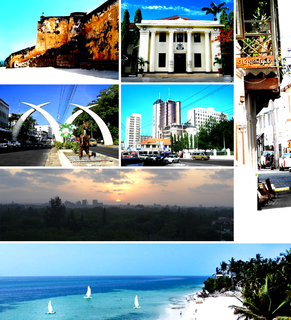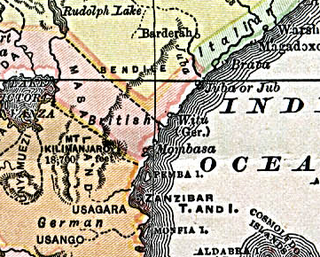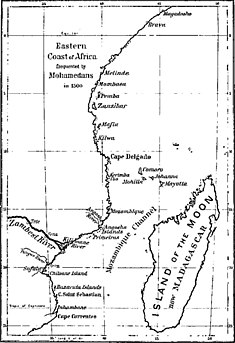
Fumo Madi ibn Abi Bakr was Sultan of Pate, Kenya (1779 - 1809). Around 1800 the Pate Sultan took over Lamu, however, they were deeply resented by the people of Lamu. Fumomadi was persuaded ("by a faithful old advisor") to build a fort on the seafront in Lamu Town, to protect members of his government. He died (a natural death) before the first storey of the fort was completed. [1]

Kenya, officially the Republic of Kenya, is a country in Africa with 47 semiautonomous counties governed by elected governors. At 580,367 square kilometres (224,081 sq mi), Kenya is the world's 48th largest country by total area. With a population of more than 52.2 million people, Kenya is the 27th most populous country. Kenya's capital and largest city is Nairobi while its oldest city and first capital is the coastal city of Mombasa. Kisumu City is the third largest city and a critical inland port at Lake Victoria. Other important urban centres include Nakuru and Eldoret.

Lamu or Lamu Town is a small town on Lamu Island, which in turn is a part of the Lamu Archipelago in Kenya. Situated 341 kilometres (212 mi) by road northeast of Mombasa that ends at Mokowe Jetty, from where the sea channel has to be crossed to reach Lamu Island. It is the headquarters of Lamu County and a UNESCO World Heritage site.

Lamu Fort is a fortress in the town of Lamu in northeastern Kenya. Originally situated on the waterfront, the fort today is located in a central position in the town, about 70 metres (230 ft) from the main jetty on the shore.
There was much disagreement over choosing his successor, as he had fifty children and all sons and male ín-laws were eligible for the throne. After "encouragement" from the powerful Mazrui family from Mombasa/Oman, an in-law named Ahmad ibn Shaykh was chosen as the next Sultan. [1]
The Mazrui were an Omani Arab clan that reigned over some areas of East Africa, especially Kenya, from the 18th to the 20th century. In the 18th century they governed Mombasa and other coastal places and opposed the Omani Al Bu Sa'id Dynasty that ruled over Zanzibar. On at least one occasion they attacked Stone Town allying with the Portuguese.

Mombasa is a coastal city of Kenya along the Indian Ocean. It is the country's oldest and second-largest city, with an estimated population of about 1.5 million people in 2017. Its metropolitan region is the second largest in the country and has a population of approximately 3 million people. Administratively, Mombasa is the county seat of Mombasa County.

Oman, officially the Sultanate of Oman, is an Arab country on the southeastern coast of the Arabian Peninsula in Western Asia. Its official religion is Islam.












